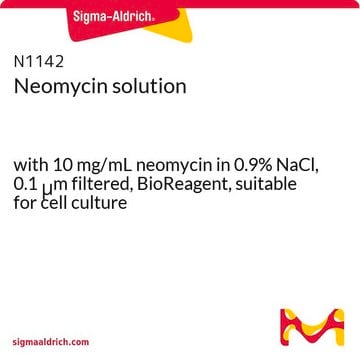P9620
Puromycin dihydrochloride
Ready Made Solution, from Streptomyces alboniger, 10 mg/mL in H2O, suitable for cell culture
Sinónimos:
3′-(L-α-Amino-p-methoxyhydrocinnamamido)-3′-deoxy-N,N-dimethyladenosine dihydrochloride, Stylomycin dihydrochloride
About This Item
Productos recomendados
biological source
Streptomyces alboniger
Quality Level
type
for cell culture
assay
>98% (HPLC)
form
solution
storage condition
(Store in cool place. Keep container tightly closed in a dry and well -ventilated place. )
concentration
10 mg/mL in H2O
technique(s)
cell culture | mammalian: suitable
color
colorless to yellow
solubility
H2O: soluble 10 mg/mL
antibiotic activity spectrum
Gram-positive bacteria
neoplastics
parasites
mode of action
protein synthesis | interferes
shipped in
wet ice
storage temp.
−20°C
SMILES string
Cl.Cl.COc1ccc(C[C@H](N)C(=O)N[C@H]2[C@@H](O)[C@@H](O[C@@H]2CO)n3cnc4c(ncnc34)N(C)C)cc1
InChI
1S/C22H29N7O5.2ClH/c1-28(2)19-17-20(25-10-24-19)29(11-26-17)22-18(31)16(15(9-30)34-22)27-21(32)14(23)8-12-4-6-13(33-3)7-5-12;;/h4-7,10-11,14-16,18,22,30-31H,8-9,23H2,1-3H3,(H,27,32);2*1H/t14-,15+,16+,18+,22+;;/m0../s1
InChI key
MKSVFGKWZLUTTO-FZFAUISWSA-N
Categorías relacionadas
General description
Puromycin′s structural similarity to the amino acid-bearing end of tRNA allows it to enter the ribosome during protein synthesis, bind to the nascent polypeptide chain, and halt chain elongation. Widely used in cell culture, puromycin serves as a selective agent for cells that have been transformed with a gene conferring resistance to puromycin.
Application
Biochem/physiol Actions
Mode of Resistance: Puromycin acetyltransferase is an effective resistance gene.
Antimicrobial Spectrum: This product is active against gram-positive microorganisms, less active against acid-fast bacilli and more weakly active against gram-negative microorganisms. Puromycin can prevent growth of bacteria, protozoa, algae and mammalian cells and acts quickly, killing 99% of cells within 2 days.
Features and Benefits
- High-quality antibiotic suitable for multiple research applications
- Antibiotic and protein synthesis inhibitor
- Effective against prokaryotic and eukaryotic cells
- Inhibits protein synthesis by interfering with RNA function
- Commonly used as a selective agent in cell biology research
Preparation Note
Other Notes
comparable product
Storage Class
10 - Combustible liquids
wgk_germany
WGK 2
flash_point_f
Not applicable
flash_point_c
Not applicable
ppe
Eyeshields, Faceshields, Gloves, multi-purpose combination respirator cartridge (US)
Certificados de análisis (COA)
Busque Certificados de análisis (COA) introduciendo el número de lote del producto. Los números de lote se encuentran en la etiqueta del producto después de las palabras «Lot» o «Batch»
¿Ya tiene este producto?
Encuentre la documentación para los productos que ha comprado recientemente en la Biblioteca de documentos.
Los clientes también vieron
Artículos
Small interfering RNAs (siRNAs) are powerful tools for gene expression knockdown, widely used in molecular biology.
Lentiviral vector systems prioritize safety features, with design precautions preventing replication. Good handling practices are essential for use.
Get tips for handling lentiviruses, optimizing experiment setup, titering lentivirus particles, and selecting helpful products for transduction.
Antibiotic kill curve is a dose response experiment in which mammalian cells are subjected to increasing amounts of selection antibiotic
Protocolos
Determine optimal antibiotic concentration for stable cell lines, ensuring efficient selection in transduced cells.
This detailed procedure allows you to transduce Mouse Embryonic Fibroblasts (MEF) using MISSION ExpressMag Super Magnetic Kit.
Lentivirus versions of genome modification technologies support successful CRISPR, RNAi, and ORF experiments.
FACS sorts cells based on light scattering and fluorescence for objective cell analysis.
Nuestro equipo de científicos tiene experiencia en todas las áreas de investigación: Ciencias de la vida, Ciencia de los materiales, Síntesis química, Cromatografía, Analítica y muchas otras.
Póngase en contacto con el Servicio técnico










